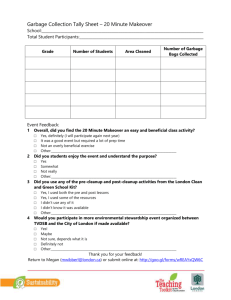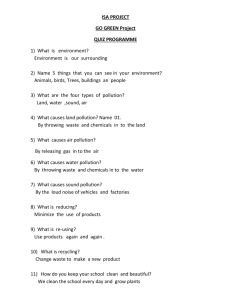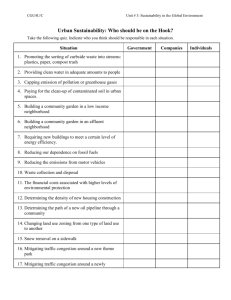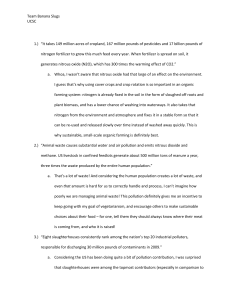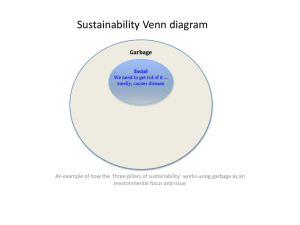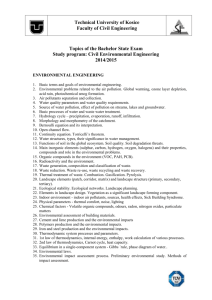Test Your GQ (Green Quotient) FINAL
advertisement
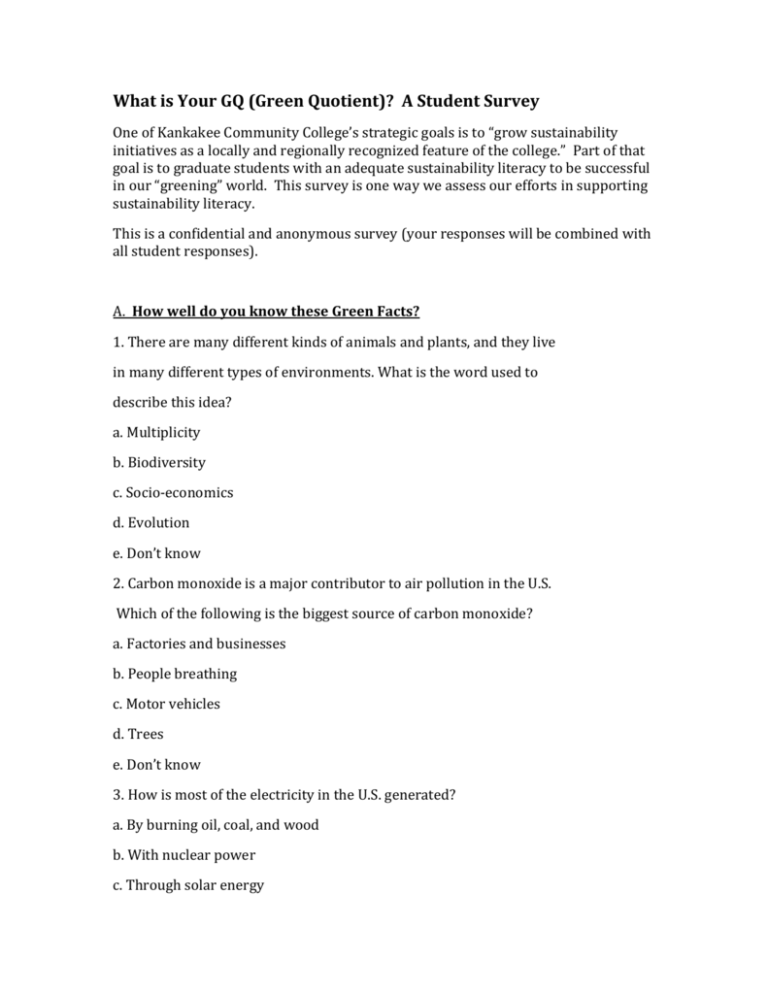
What is Your GQ (Green Quotient)? A Student Survey One of Kankakee Community College’s strategic goals is to “grow sustainability initiatives as a locally and regionally recognized feature of the college.” Part of that goal is to graduate students with an adequate sustainability literacy to be successful in our “greening” world. This survey is one way we assess our efforts in supporting sustainability literacy. This is a confidential and anonymous survey (your responses will be combined with all student responses). A. How well do you know these Green Facts? 1. There are many different kinds of animals and plants, and they live in many different types of environments. What is the word used to describe this idea? a. Multiplicity b. Biodiversity c. Socio-economics d. Evolution e. Don’t know 2. Carbon monoxide is a major contributor to air pollution in the U.S. Which of the following is the biggest source of carbon monoxide? a. Factories and businesses b. People breathing c. Motor vehicles d. Trees e. Don’t know 3. How is most of the electricity in the U.S. generated? a. By burning oil, coal, and wood b. With nuclear power c. Through solar energy d. At hydroelectric power plants e. Don’t know 4. What is the most common cause of pollution of streams, rivers, and oceans? a. Dumping of garbage by cities b. Surface water running off yards, city streets, paved lots, and farm fields c. Trash washed into the ocean from beaches d. Waste dumped by factories e. Don’t know 5. Which of the following is a renewable resource? a. Oil b. Iron ore c. Trees d. Coal e. Don’t know 6. Ozone forms a protective layer in the earth’s upper atmosphere. What does ozone protect us from? a. Acid rain b. Global warming c. Sudden changes in temperature d. Harmful, cancer-causing sunlight e. Don’t know 7. Where does most of the garbage in the U.S. end up? a. Oceans b. Incinerators c. Recycling centers d. Landfills e. Don’t know 8. What is the name of the primary federal agency that works to protect the environment? a. Environmental Protection Agency (the EPA) b. Department of Health, Environment, and Safety (the DHES) c. National Environmental Agency (the NEA) d. Federal Pollution Control Agency (the FPCA) e. Don’t know 9. Which of the following household wastes is considered hazardous waste? a. Plastic packaging b. Glass c. Batteries d. Spoiled food e. Don’t know 10. What is the most common reason that an animal species becomes extinct? a. Pesticides are killing them b. Their habitats are being destroyed by humans c. There is too much hunting d. There are climate changes that affect them e. Don’t know 11. Scientists have not determined the best solution for disposing of nuclear waste. In the U.S., what do we do with it now? a. Use it as nuclear fuel b. Sell it to other countries c. Dump it in landfills d. Store and monitor the waste e. Don’t know 12. What is the primary benefit of wetlands? a. Promote flooding b. Help clean the water before it enters lakes, streams, rivers, or oceans c. Help keep the number of undesirable plants and animals low d. Provide good sites for landfills e. Don’t know 13. Does insulating your home a. keep out air pollution? b. help to reduce the greenhouse effect? c. make you ozone-friendly? d. cost more to install than it saves in fuel bills? e. Don’t know 14. Which choice of front door would be the most ecologically sound? a. an inexpensive molded door b. a solid mahogany door c. a handcrafted English oak door d. a period door from an architectural salvage company. e. Don’t know 15. Tree planting is being encouraged to combat global warming. Which variety should you choose? a. a fast-growing sycamore b. a long-lived British oak c. a variety native to your region d. an evergreen conifer. e. Don’t know 16. Which of the following is associated with deforestation? a. drought b. flooding c. malnutrition d. All of the above e. Don’t know 17. Which of the following can pollute indoor air ? a. smoking b. paint c. chipboard furniture. d. All of the above e. Don’t know 18. Which is the most effective method of saving natural resources and conserving energy? a. making biodiesel from waste food oils b. returnable bottles c. aluminum collection schemes d. saving newspapers e. Don’t know 19. If you want a patio or path in your garden, you should lay a. inexpensive, durable concrete b. stone paving c. old stone or brick d. green Astroturf e. Don’t know 20. Which is the most ecologically sound quick meal? a. frozen vegetarian lasagna b. take-out Mexican bean burrito c. a baked potato, cheese and beer d. a hamburger in a paper pack. e. Don’t know 21. `Sustainability’ means a. using natural resources as slowly as possible b. using only as much as is replaced by natural processes c. not introducing new technology too quickly d. discovering new resources to allow maximum economic growth. e. Don’t know 22. Newer technologies are often better. Buying a brand new, gas-powered car is a. less energy efficient than keeping an old car well maintained b. as efficient as driving a hybrid c. more efficient than driving an old car, even if it's an SUV d. Don’t know 23. If every American replaced one incandescent light bulb with a fluorescent a. Homes would be much less energy efficient b. It would be like taking 1,000 cars off the road for one year c. It would be like taking 1 million cars off the road for one year d. Don’t know 24. Americans account for about 5 percent of the world's population and a. About 50 percent of the world's energy consumption b. About 25 percent of the world's energy consumption c. About 10 percent of the world's energy consumption d. Don’t know 25. Water shortages are a new reality. At about 500,000 gallons per person per year, Americans consume approximately a. Double the average in other developed nations b. Double the average in Third World nations c. The same as most Europeans d. Don’t know 26. Landfills are spilling over, caused by an annual output of about a. 100 pounds of garbage per person b. 1,600 pounds of garbage per household c. 1,600 pounds of garbage per person d. Don’t know 27. Swapping a 10-year-old refrigerator for a newer, more efficient model saves a. Enough energy to light your home for 3 months b. Enough energy heat your home for 6 months c. Enough energy light and heat your home for one year d. Don’t know B Some Questions about You 1. Had you taken any courses in high school with significant environmental content? a. yes b. no 2. Do you plan to take at least one course at Kankakee Community College with significant environmental content? a. definitely not b. probably not c. unsure d. probably yes e. definitely yes 3. Are you considering a major or minor in environmental science or policy or some kind of sustainability focus at KCC? a. definitely not b. probably not c. unsure d. probably yes e. definitely yes 4. Do you plan to engage in environmental/sustainability activities while at KCC? a. definitely not b. probably not c. unsure d. probably yes e. definitely yes 5. To what extent do you consider the environmental impacts of your daily activities and choices? a. not at all b. somewhat c. quite a bit d. a great deal 6. Which of the following is the most important environmental issue facing the U.S. in your opinion? a. air pollution b. energy conservation c. global climate change d. land and habitat conservation e. water conservation and/or pollution 7. How many of the following behaviors do you do on a daily basis: Recycling, using alternative transportation, choosing local/and or organic food, conserving energy, conserving water? a. None b. 1 or 2 c. 3 or 4 d. 5 or 6 8. How informed do you think other people your age are about climate change? a. very uninformed b. somewhat uninformed c. neither informed nor uninformed d. somewhat informed e. very informed 9. There’s no point in taking any personal action to slow climate change because whatever I do won’t make any real difference. a. strongly disagree b. disagree c. neither agree nor disagree d. agree e. strongly agree
